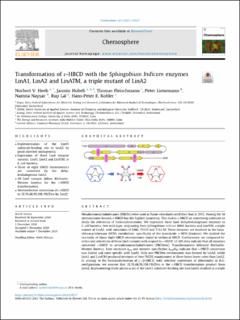Please use this identifier to cite or link to this item:
https://doi.org/10.21256/zhaw-28380| Publication type: | Article in scientific journal |
| Type of review: | Peer review (publication) |
| Title: | Transformation of ε-HBCD with the Sphingobium Indicum enzymes LinA1, LinA2 and LinATM, a triple mutant of LinA2 |
| Authors: | Heeb, Norbert V. Hubeli, Jasmin Fleischmann, Thomas Lienemann, Peter Nayyar, Namita Lal, Rup Kohler, Hans-Peter E. |
| et. al: | No |
| DOI: | 10.1016/j.chemosphere.2020.129217 10.21256/zhaw-28380 |
| Published in: | Chemosphere |
| Volume(Issue): | 267 |
| Page(s): | 129217 |
| Issue Date: | 7-Dec-2020 |
| Publisher / Ed. Institution: | Elsevier |
| ISSN: | 0045-6535 1879-1298 |
| Language: | English |
| Subjects: | Biotransformation; Escherichia coli; Hexachlorocyclohexane; Stereoisomerism; Flame retardants; Hydrocarbons, brominated; Sphingomonadaceae |
| Subject (DDC): | 572: Biochemistry |
| Abstract: | Hexabromocyclododecanes (HBCDs) were used as flame-retardants until their ban in 2013. Among the 16 stereoisomers known, ε-HBCD has the highest symmetry. This makes ε-HBCD an interesting substrate to study the selectivity of biotransformations. We expressed three LinA dehydrohalogenase enzymes in E. coli bacteria, two wild-type, originating from Sphingobium indicum B90A bacteria and LinATM, a triple mutant of LinA2, with mutations of L96C, F113Y and T133 M. These enzymes are involved in the hexachlorocyclohexane (HCH) metabolism, specifically of the insecticide γ-HCH (Lindane). We studied the reactivity of those eight HBCD stereoisomers found in technical HBCD. Furthermore, we compared kinetics and selectivity of these LinA variants with respect to ε-HBCD. LC-MS data indicate that all enzymes converted ε-HBCD to pentabromocyclododecenes (PBCDens). Transformations followed Michaelis-Menten kinetics. Rate constants kcat and enzyme specificities kcat/KM indicate that ε-HBCD conversion was fastest and most specific with LinA2. Only one PBCDen stereoisomer was formed by LinA2, while LinA1 and LinATM produced mixtures of two PBCDE enantiomers at three times lower rates than LinA2. In analogy to the biotransformation of (-)β-HBCD, with selective conversion of dibromides in R-S-configuration, we assume that 1E,5S,6R,9S,10R-PBCDen is the ε-HBCD transformation product from LinA2. Implementing three amino acids of the LinA1 substrate-binding site into LinA2 resulted in a triple mutant with similar kinetics and product specificity like LinA1. Thus, point-directed mutagenesis is an interesting tool to modify the substrate- and product-specificity of LinA enzymes and enlarge their scope to metabolize other halogenated persistent organic pollutants regulated under the Stockholm Convention. |
| URI: | https://digitalcollection.zhaw.ch/handle/11475/28380 |
| Fulltext version: | Published version |
| License (according to publishing contract): | CC BY 4.0: Attribution 4.0 International |
| Departement: | Life Sciences and Facility Management |
| Organisational Unit: | Institute of Chemistry and Biotechnology (ICBT) |
| Appears in collections: | Publikationen Life Sciences und Facility Management |
Files in This Item:
| File | Description | Size | Format | |
|---|---|---|---|---|
| 2020_Heeb-et-al_Transformation-of-the-e-HBCD.pdf | 4.23 MB | Adobe PDF |  View/Open |
Show full item record
Heeb, N. V., Hubeli, J., Fleischmann, T., Lienemann, P., Nayyar, N., Lal, R., & Kohler, H.-P. E. (2020). Transformation of ε-HBCD with the Sphingobium Indicum enzymes LinA1, LinA2 and LinATM, a triple mutant of LinA2. Chemosphere, 267, 129217. https://doi.org/10.1016/j.chemosphere.2020.129217
Heeb, N.V. et al. (2020) ‘Transformation of ε-HBCD with the Sphingobium Indicum enzymes LinA1, LinA2 and LinATM, a triple mutant of LinA2’, Chemosphere, 267, p. 129217. Available at: https://doi.org/10.1016/j.chemosphere.2020.129217.
N. V. Heeb et al., “Transformation of ε-HBCD with the Sphingobium Indicum enzymes LinA1, LinA2 and LinATM, a triple mutant of LinA2,” Chemosphere, vol. 267, p. 129217, Dec. 2020, doi: 10.1016/j.chemosphere.2020.129217.
HEEB, Norbert V., Jasmin HUBELI, Thomas FLEISCHMANN, Peter LIENEMANN, Namita NAYYAR, Rup LAL und Hans-Peter E. KOHLER, 2020. Transformation of ε-HBCD with the Sphingobium Indicum enzymes LinA1, LinA2 and LinATM, a triple mutant of LinA2. Chemosphere. 7 Dezember 2020. Bd. 267, S. 129217. DOI 10.1016/j.chemosphere.2020.129217
Heeb, Norbert V., Jasmin Hubeli, Thomas Fleischmann, Peter Lienemann, Namita Nayyar, Rup Lal, and Hans-Peter E. Kohler. 2020. “Transformation of ε-HBCD with the Sphingobium Indicum Enzymes LinA1, LinA2 and LinATM, a Triple Mutant of LinA2.” Chemosphere 267 (December): 129217. https://doi.org/10.1016/j.chemosphere.2020.129217.
Heeb, Norbert V., et al. “Transformation of ε-HBCD with the Sphingobium Indicum Enzymes LinA1, LinA2 and LinATM, a Triple Mutant of LinA2.” Chemosphere, vol. 267, Dec. 2020, p. 129217, https://doi.org/10.1016/j.chemosphere.2020.129217.
Items in DSpace are protected by copyright, with all rights reserved, unless otherwise indicated.